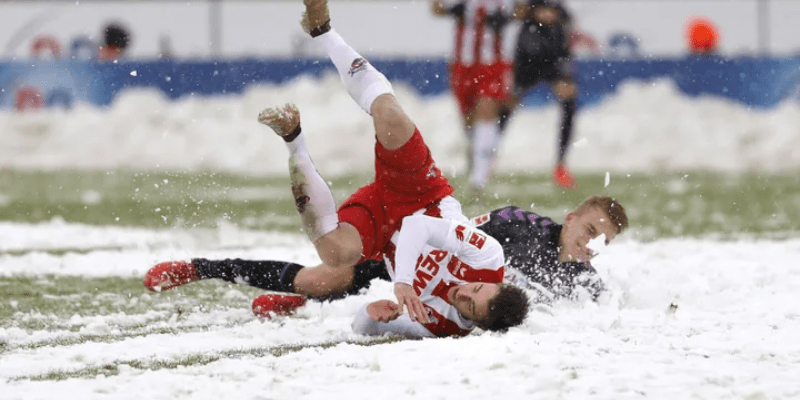In this article, AtiGoal will accompany you to explore whether the Bundesliga has winter break, when it happens, how long it lasts, why it exists, and what impact it has on clubs and players. If you’ve ever wondered how Germany handles the cold and mid-season rest, you’re in the right place.
What is the Bundesliga winter break

Yes, the Bundesliga does have a winter break. Each season, the German top-flight league pauses during the coldest months of December and resumes in January. This break—commonly known in German as Winterpause—gives teams time to rest, recover.
When and how long is the winter break
Here’s a breakdown of typical dates and durations, and what’s happening in the 2025-26 season:
- For the 2024-25 Bundesliga season, the winter break began after Matchday 15 on 22 December 2024 and the league resumed on 10 January 2025.
- In the 2025-26 season, the break will begin after Matchday 15 (19-21 December 2025) and matches will resume on 9 January 2026.
- The Bundesliga 2 (second division) typically resumes slightly after the top flight – in 2025-26 it returns on 16 January 2026.
Duration
The winter break generally lasts about 2½ to 3½ weeks, depending on how the calendar and matchdays fall around Christmas and New Year. It’s long enough to allow for rest, limited training, sometimes winter training camps, but not a full month in most seasons.
Why does Bundesliga have a winter break

There are several reasons why this pause in the schedule exists—and why it’s deeply embedded in the structure of German football.
- Weather and pitch conditions
- Cold winter months in Germany can bring snow, freezing temperatures, frost, and adverse pitch conditions. The break allows stadiums and groundskeepers to maintain fields and avoid playing under dangerous or subpar circumstances.
- Player welfare
- The Bundesliga has many matches in tight windows—league, domestic cups, European competitions, international breaks. The winter break helps reduce risk of fatigue, injury, and burnout.
- Tactical reset and training opportunities
- Clubs often use this time for mid-season assessments. Coaches can work on strategies, fix issues from the first half of the season (Hinrunde), integrate new players, adjust squads, and prepare for the second half.
- Scheduling around holidays
- Christmas and New Year are big holidays in Germany. Giving players and staff time off, avoiding business around those dates, plus fan considerations, are all part of why the break is scheduled as it is.
How winter breaks in Bundesliga compare to other leagues

The Bundesliga isn’t alone in pausing or slowing down over winter—many European leagues have some break or lighter schedule—but Germany’s is relatively formal and consistent.
- Some leagues (e.g. in Scandinavia) even suspend play entirely during deep winter due to weather.
- Others, like in England’s Premier League, rarely stop for long, treating December and January as packed fixture zones.
- Therefore, the Bundesliga’s winter break strikes a balance: not too long to disrupt momentum, but long enough to offer relief and recovery.
Case studies & recent changes
To illustrate how this plays out in practice:
- In 2024-25, the break was roughly from 22 December to 10 January. That’s about 2½–3 weeks.
- The 2025-26 calendar confirms Matchday 15 (mid-Dec) before break, and return 9 January. Bundesliga 2 returns a week later.
These timeframes help teams manage injuries, rest key players, especially those involved in European and international duties where travel and extra matches pile up.
Pros and cons of the winter break
Let’s weigh what the break offers and what downsides emerge:
Pros
- Improved player fitness and fewer injuries in the back half of the season
- Opportunity for coaching adjustments and tactical flexibility
- Recovery from mid-season fatigue, both physical and mental
- Allows for warming up pitches, maintaining stadiums, better match quality
Cons
- Losing competitive momentum—teams on a hot streak might cool off
- Training camps may substitute poorly for real matches
- Some clubs may struggle to keep form during break if disrupted
- Fixture congestion before and after the break (more matches in tight windows)
What fans need to know for 2025-26
If you’re following Bayern Munich, Borussia Dortmund, RB Leipzig or any Bundesliga side in 2025-26, here’s what to mark on your calendar:
- Bundesliga winter break after Matchday 15, which falls on 19-21 December 2025.
- Resumption: 9 January 2026 for the Bundesliga. Bundesliga 2 returns 16 January 2026.
- This means around 3 weeks without league fixtures, during which clubs may schedule friendlies, training camps, and recover injuries.
Conclusion
AtiGoal hopes this clears up exactly does Bundesliga have winter break — yes, it does, and it’s a regular, essential part of the German football season. It usually lasts around 2½ to 3 weeks, happening over late December into early January. For 2025-26, expect the pause to begin in mid-December and resume on 9 January for the Bundesliga.
If you want, AtiGoal can also pull together a comparison of winter breaks across Europe—how long different leagues pause, when they schedule them, and what works best. Want me to do that? Also, feel free to ask for the exact fixture schedule of your favourite club around the winter break.







